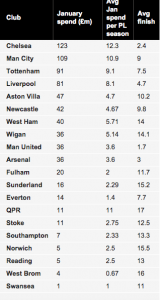It is halfway through the 2014-2015 season, which means that the winter transfer window is now going on. Established during the 2002-2003 season of the English Premier League, the present transfer window system was introduced as a way to best preserve contractual stability for both the player and the club while allowing movement to occur at predetermined times. This allowed for contracts to be enforced and for the integrity of competitions to be maintained.
Transfer windows are both welcomed and feared by fans. For a fan whose team has not been living up to expectations, the transfer window is seen as an opportunity to buy a player who can be a real game changer. On the other hand, fans can definitely feel anxious about a team offloading strong players who just do not fit the manager’s future plans (believe me, I’m a Real Madrid fan so I know). The great thing about having two solidly set transfer windows is that fans will know that the squad will be settled for at least two parts of the season.
While the summer transfer window is when most of the excitement takes place, the January transfer window is also important and can deliver on some headline stealing deals. Since it occurs halfway through the season, it has the potential to make or break a team, fuel or terminate a season, and create or dismantle a player’s reputation. A January signing also differs from a summer signing in that the manager will need immediate impact from a January signing while a summer signing can be a way to invest in the future team.
The January transfer window has gathered mixed reactions from managers and players. It is complicated by different leagues’ time constraints, possible European and domestic cup ineligibility, and clubs resolutely holding on to their best players. This leads to inflated prices by the selling party, which means a preference for clubs who have strong finances to participate in this transfer window. Take for example the 2011 winter transfer window. Fernando Torres, unhappy with Liverpool’s situation, handed in his official transfer request and was sold to Chelsea for £50 million, making him the sixth most expensive footballer in history. With this money, Liverpool was able to then spend £35.5 million on Andy Carroll and £22.5 million on Luis Suarez. It should come of no surprise that Chelsea and Liverpool are two of the top January transfer window spenders.
While the 2011 winter transfer season is definitely an exception, setting the record for the most spending for a winter transfer window at £225 million, it is clear that the January transfer window is not as low-key as some may think. Going back to the aforementioned example, the purchase of Luis Suarez became a pivotal moment for Liverpool. He went on to become a crucial player for the club and led the team to a 2nd place finish in the EPL. His transfer to FC Barcelona this season is strongly felt by Liverpool, as they are currently struggling to compete with the likes of Manchester United, Chelsea, etc. in the EPL (although I am sure Liverpool fans don’t miss the controversy and biting that surrounds him). On the other hand, Fernando Torres did not live up to the £50 million price tag, and received criticism for his low goal-scoring record.
As the competition heats up for all the leagues and cups, the January transfer window will prove important in shaping the rest of the season for many clubs. Those in relegation also will be looking to purchase players who can shake up the team. As an avid watcher of the English Premier League, I am looking forward to seeing some new players on my screen who can potentially become the next superstar.
Sources:
http://www.bbc.co.uk/sport/0/football/20793698
http://www.premierleague.com/en-gb/news/features/origins-of-transfer-window.html

